Influences of Deep Foundation Pit Excavation on the Stability of Adjacent Ancient Buildings
Abstract
:1. Introduction
2. Research Background
2.1. Overview of Foundation Pit
2.2. Overview of Surrounding Building
3. Monitoring and Result Analysis of Foundation Pit Excavation
3.1. Time–History Curves of Horizontal Displacement of Diaphragm Wall
3.2. Time–History Curve of Settlement of Ancient Building
4. Numerical Simulation
4.1. Establishment of Numerical Model
4.2. Comparison between Field Measurement and Numerical Calculation
- (1)
- Diaphragm Wall Deformation
- (2)
- Settlement of Ancient Building
4.3. Influence of Foundation Pit Excavation on Ground Settlement
4.4. Influence of Foundation Pit Excavation on Adjacent Building
- (1)
- Settlement of Building
- (2)
- Shear Strain of Building
4.5. Influence of MJS Pile Parameters on Building Settlement
- (1)
- Influence of MJS Pile Depth
- (2)
- Influence of MJS Pile Position
5. Conclusions
- (1)
- As the excavation depth of the foundation pit increases, the horizontal displacement of the diaphragm wall increases, the settlement difference of the building increases and the building inclines toward the middle of the foundation pit.
- (2)
- The maximum shear strain of the building’s wall is caused by the settlement difference of the building, which mainly occurs on both sides of the doors and windows and on the left and right corners of the wall. During the construction of foundation pits, key monitoring and protection should be carried out in these areas.
- (3)
- Upon using MJS pile reinforcement, the deformation of the diaphragm wall is significantly reduced. The maximum settlement difference and wall deformation of the ancient building is only one third of that when foregoing MJS pile reinforcement, indicating that MJS pile reinforcement played a good protective role for the ancient building in question.
- (4)
- The closer the MJS pile is to the building or the deeper the MJS pile is, the smaller the building’s settlement difference. When the depth of the MJS pile is greater than one times the depth of the foundation pit, its reinforcement effect is not significantly improved. Therefore, the depth of MJS piles in engineering should be the same as the depth of foundation pits.
Funding
Data Availability Statement
Conflicts of Interest
References
- Han, M.; Li, Z.; Mei, G.; Bao, X.; Jia, J.; Liu, L.; Li, Y. Characteristics of subway excavation in soft soil and protective effects of partition wall on the historical building and pile foundation building. Bull. Eng. Geol. Environ. 2022, 81, 307. [Google Scholar] [CrossRef]
- Dmochowski, G.; Szolomicki, J. Technical and structural problems related to the interaction between a deep excavation and adjacent existing buildings. Appl. Sci. 2021, 11, 481. [Google Scholar] [CrossRef]
- De Vita, M.; Massari, G.; De Berardinis, P. Retrofit methodology based on energy simulation modeling applied for the enhancement of a historical building in L’Aquila. Energies 2020, 13, 3289. [Google Scholar] [CrossRef]
- Xue, H.J. Research on the control of excavation deformation of super deep foundation pit adjacent to the existing old masonry structure building. Sustainability 2023, 15, 7697. [Google Scholar] [CrossRef]
- Wei, H. Influence of foundation pit excavation and precipitation on settlement of surrounding buildings. Adv. Civ. Eng. 2021, 2021, 6638868. [Google Scholar] [CrossRef]
- Wang, G.; Chen, W.; Cao, L.; Li, Y.; Liu, S.; Yu, J.; Wang, B. Retaining technology for deep foundation pit excavation adjacent to high-speed railways based on deformation control. Front. Earth Sci. 2021, 9, 735315. [Google Scholar] [CrossRef]
- Angiolilli, M.; Gregori, A.; Cattari, S. Performance of fiber reinforced mortar coating for irregular stone masonry: Experimental and analytical investigations. Constr. Build. Mater. 2021, 294, 37–42. [Google Scholar] [CrossRef]
- Boone, S.J.; Westland, J.; Nusink, R. Comparative evaluation of building responses to an adjacent braced excavation. Can. Geotech. J. 1999, 36, 210–223. [Google Scholar] [CrossRef]
- Zhao, Y.S.; Wang, B.L.; Zhou, S.H. Monitoring and analysis of the influence of foundation pit excavation on adjacent buildings. Undergr. Space 2000, 20, 51–53. (In Chinese) [Google Scholar]
- Ou, C.Y.; Teng, F.; Li, C.W. A simplified estimation of excavation-induced ground movements for adjacent building damage potential assessment. Tunn. Undergr. Space Technol. 2020, 106, 103561. [Google Scholar] [CrossRef]
- Zhao, C.; Feng, Y.; Wang, W.; Niu, Z. Mechanical properties and numerical analysis of underground continuous wall in underground grain silo foundation pit. Buildings 2023, 13, 293. [Google Scholar] [CrossRef]
- Wu, J.; Ye, S.; Wang, Z.; Yang, D. Application and automatic monitoring and analysis of hybrid support structure in ultra-deep foundation pit engineering in the Lanzhou area under complex environmental conditions. Water 2023, 15, 1335. [Google Scholar] [CrossRef]
- Górska, K.; Muszyński, Z.; Rybak, J. Displacement monitoring and sensitivity analysis in the observational method. Stud. Geotech. Et Mech. 2013, 35, 25–43. [Google Scholar] [CrossRef]
- Zhang, J.; Chen, Z.; Hu, M.; Wu, Z. Study on deep and large foundation pit of a national first-class key tomb protection project. Adv. Civ. Eng. 2021, 2021, 1–12. [Google Scholar] [CrossRef]
- Chen, W.; Wei, X.; Fan, J.; Yang, K.; Yao, X. Monitoring analysis of a deep foundation pit construction adjacent to old buildings. IOP Conf. Ser. Mater. Sci. Eng. 2020, 780, 052015. [Google Scholar] [CrossRef]
- Li, Z.; Han, M.; Liu, L.; Li, Y.; Yan, S. Corner and partition wall effects on the settlement of a historical building near a supported subway excavation in soft soil. Comput. Geotech. 2020, 128, 103805. [Google Scholar] [CrossRef]
- Wang, G. Optimization of seismic reinforcement technology for multi-storey brick masonry structures under differential settlement. Sci. Technol. Eng. 2018, 18, 194–200. [Google Scholar]
- Tang, M.F.; Pu, M.; Gui, J.G. Analysis on influence of excavation of metro station's deep foundation pit upon adjacent buildings. Railw. Eng. 2014, 1, 88–90. (In Chinese) [Google Scholar]
- Zhai, J.Q.; Jia, J.; Xie, X.L. Practice of partition wall in the building protection projects near deep excavation. Chin. J. Undergr. Space Eng. 2010, 6, 162–166. (In Chinese) [Google Scholar]
- Ying, H.W.; Li, T.; Wang, W.F. Optimization design of partition wall in deep excavations based on 3-D numerical simulation. Rock Soil Mech. 2012, 33, 220–226. (In Chinese) [Google Scholar]
- Wu, C.J.; Zhang, Z.X.; Ding, W.Q.; Zhang, D.Y. Influences of construction of side-crossing shield tunnel on adjacent ancient architectures and reinforcement effect of protection measures. Chin. J. Geotech. Eng. 2012, 34, 158–165. (In Chinese) [Google Scholar]
- Boscardin, M.D.; Cording, E.J. Building response to excavation-induced settlement. J. Geotech. Eng. 1989, 115, 1–21. [Google Scholar] [CrossRef]


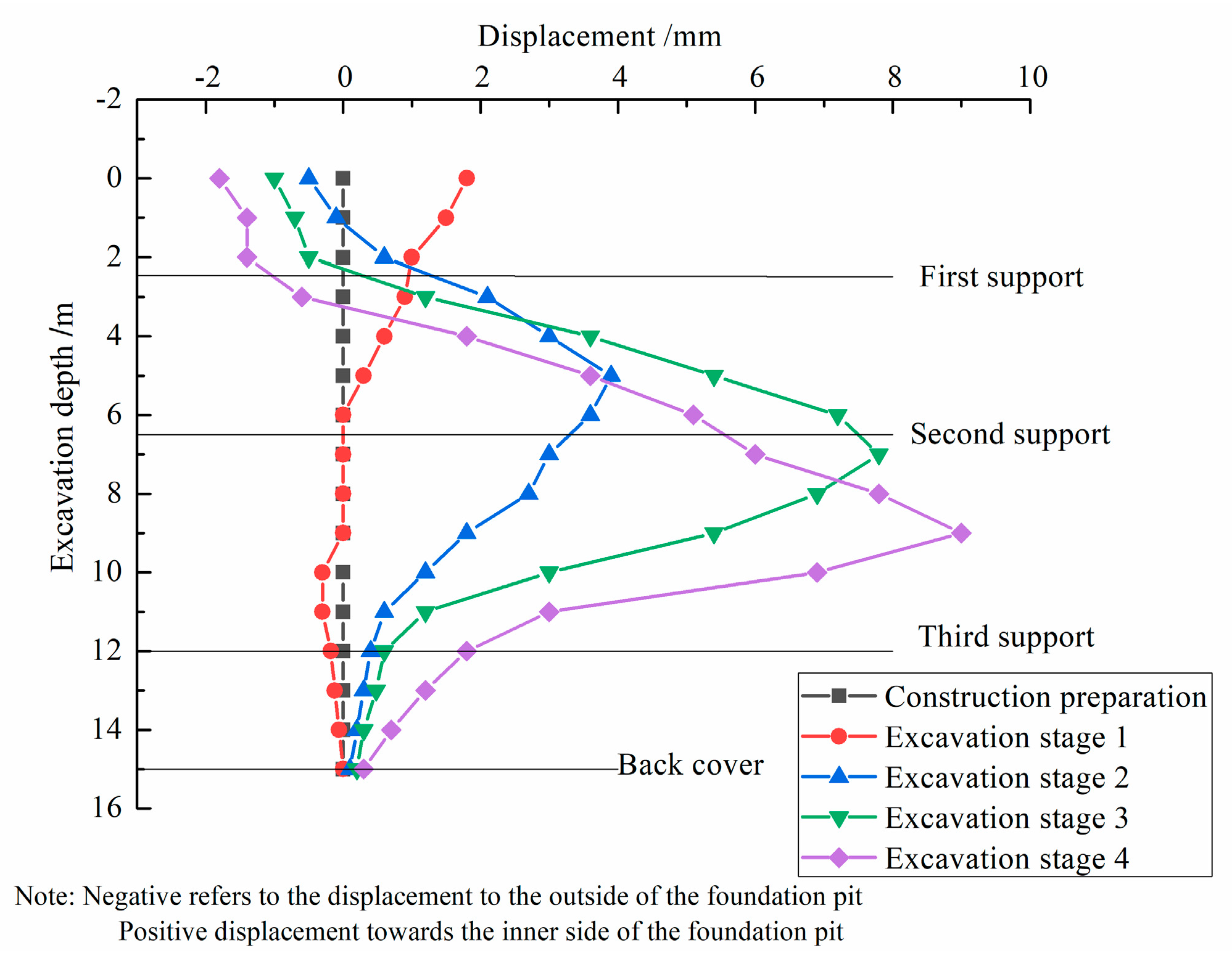


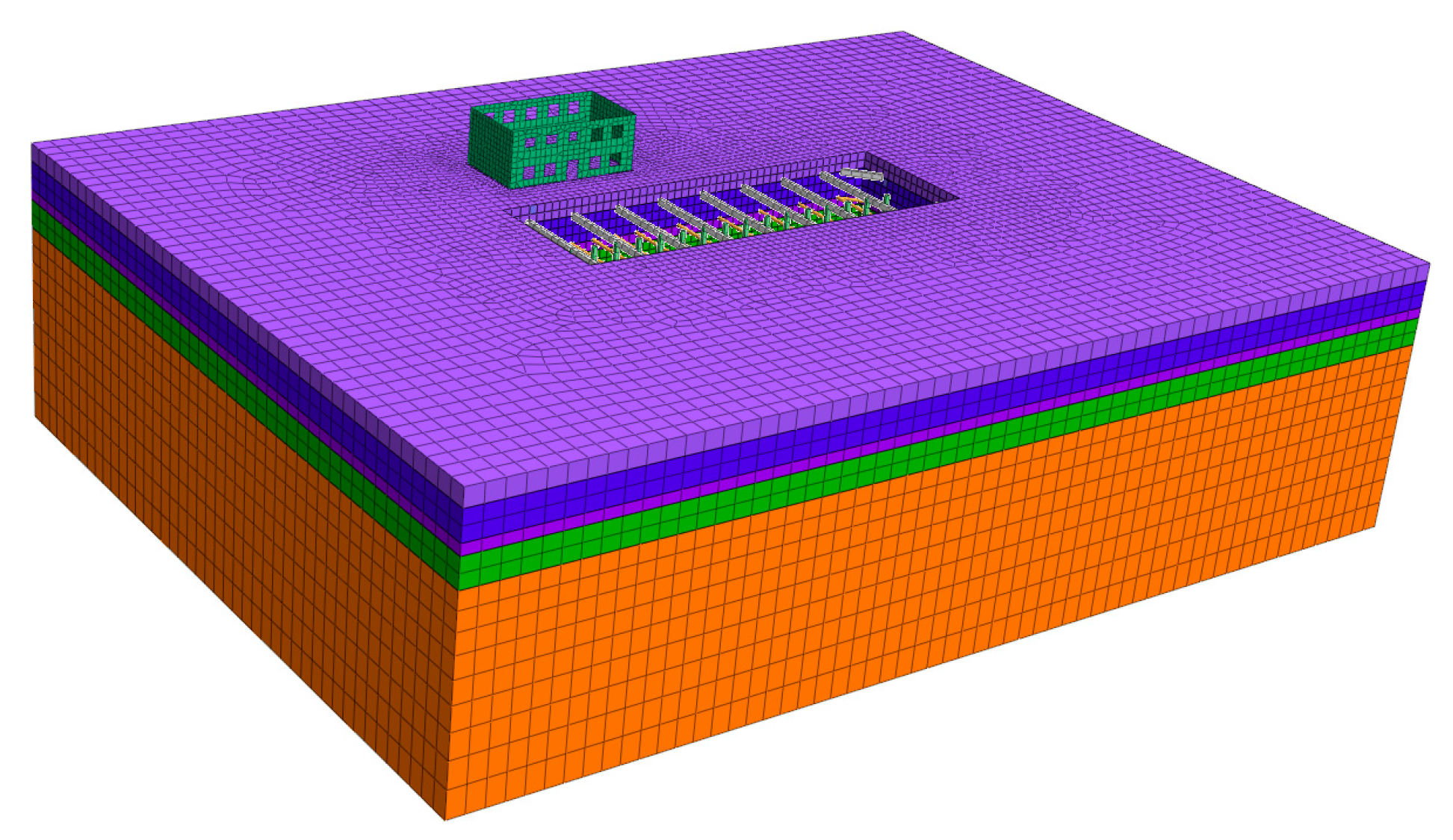


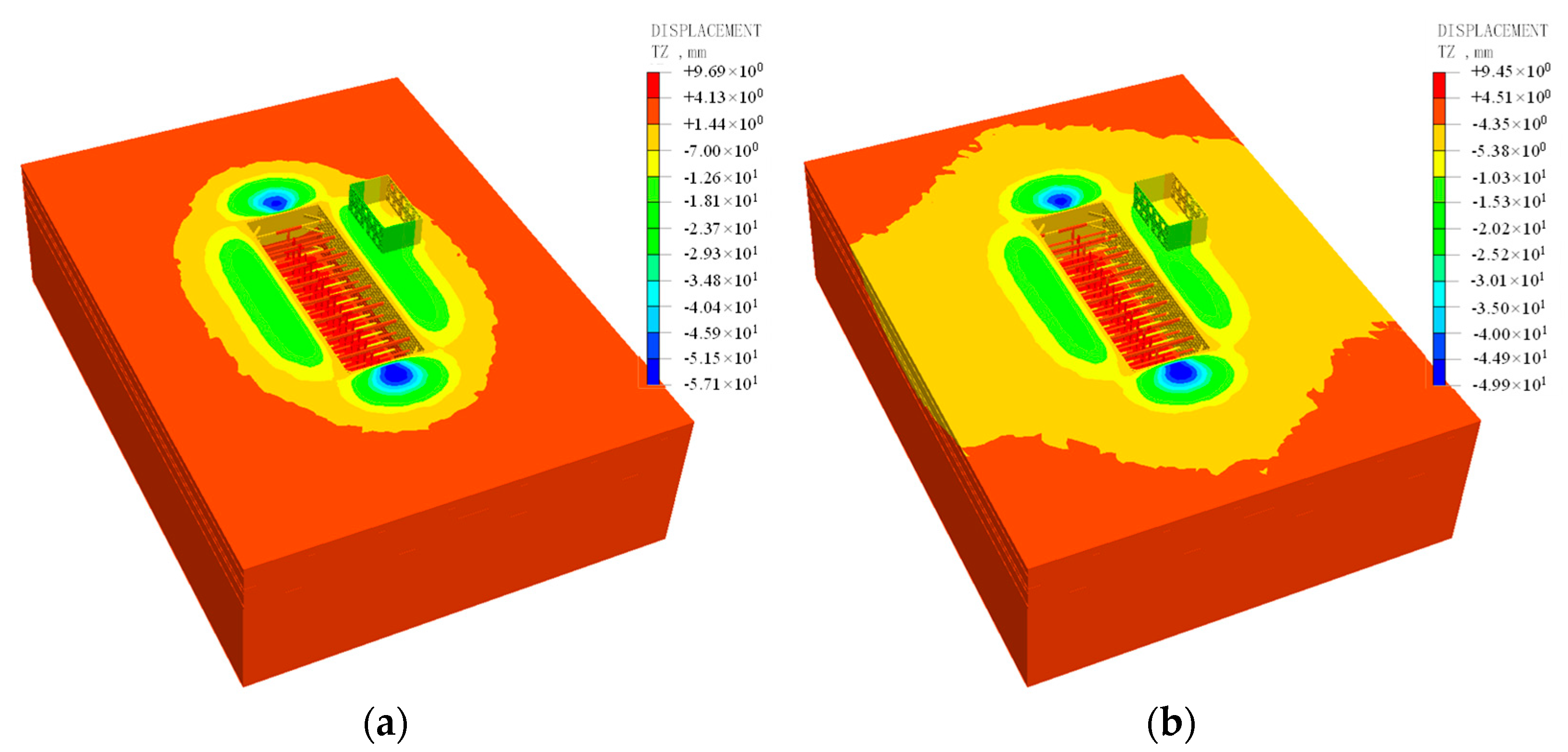
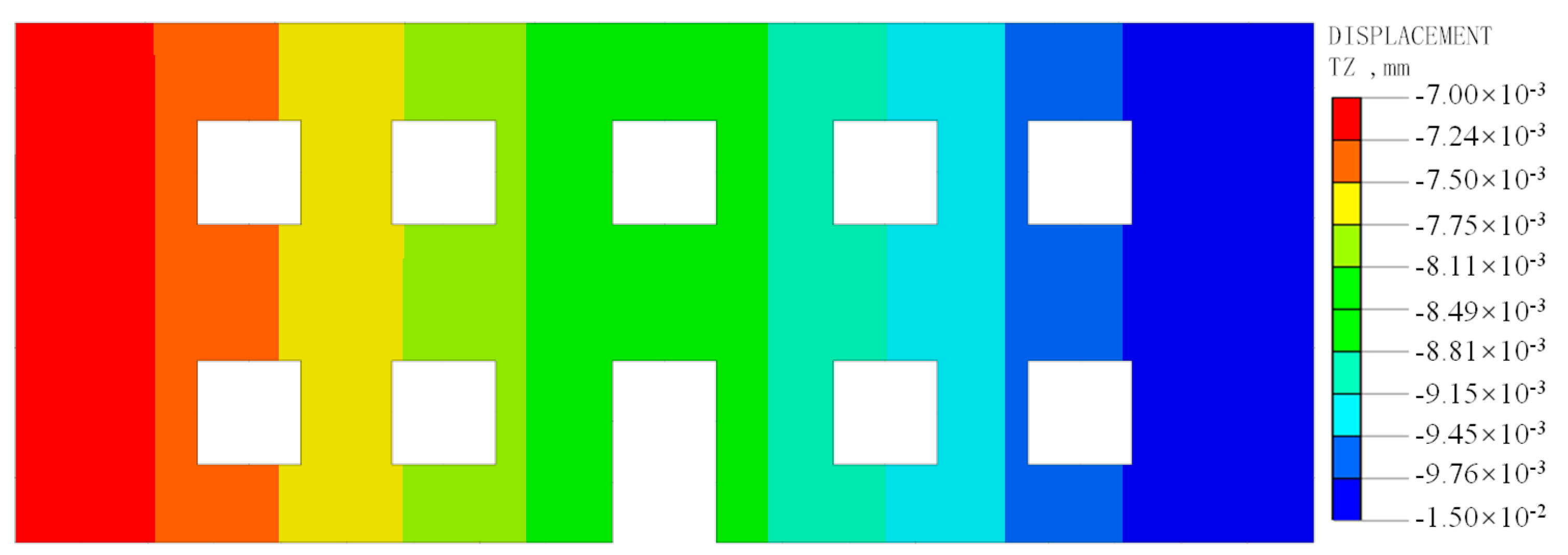




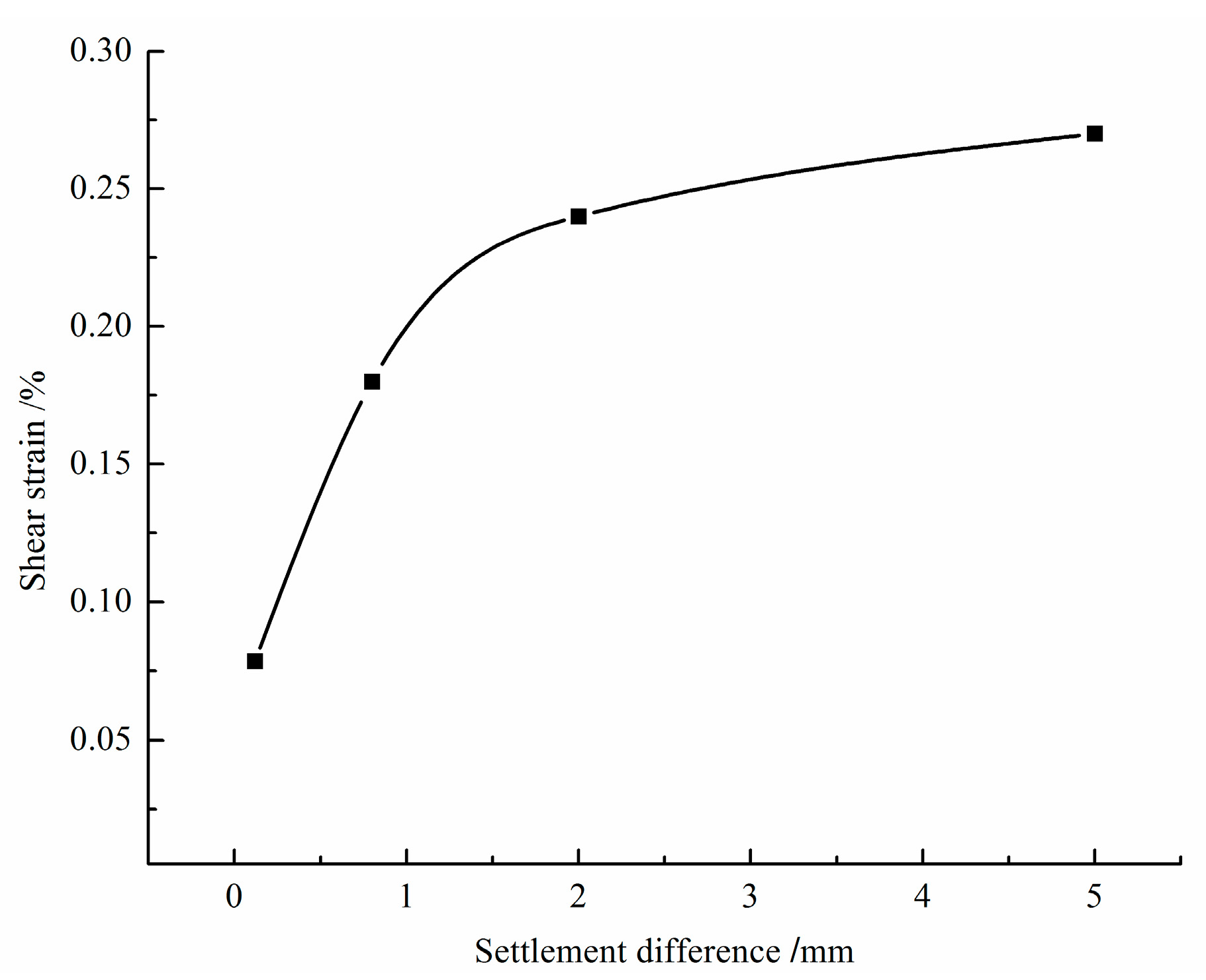
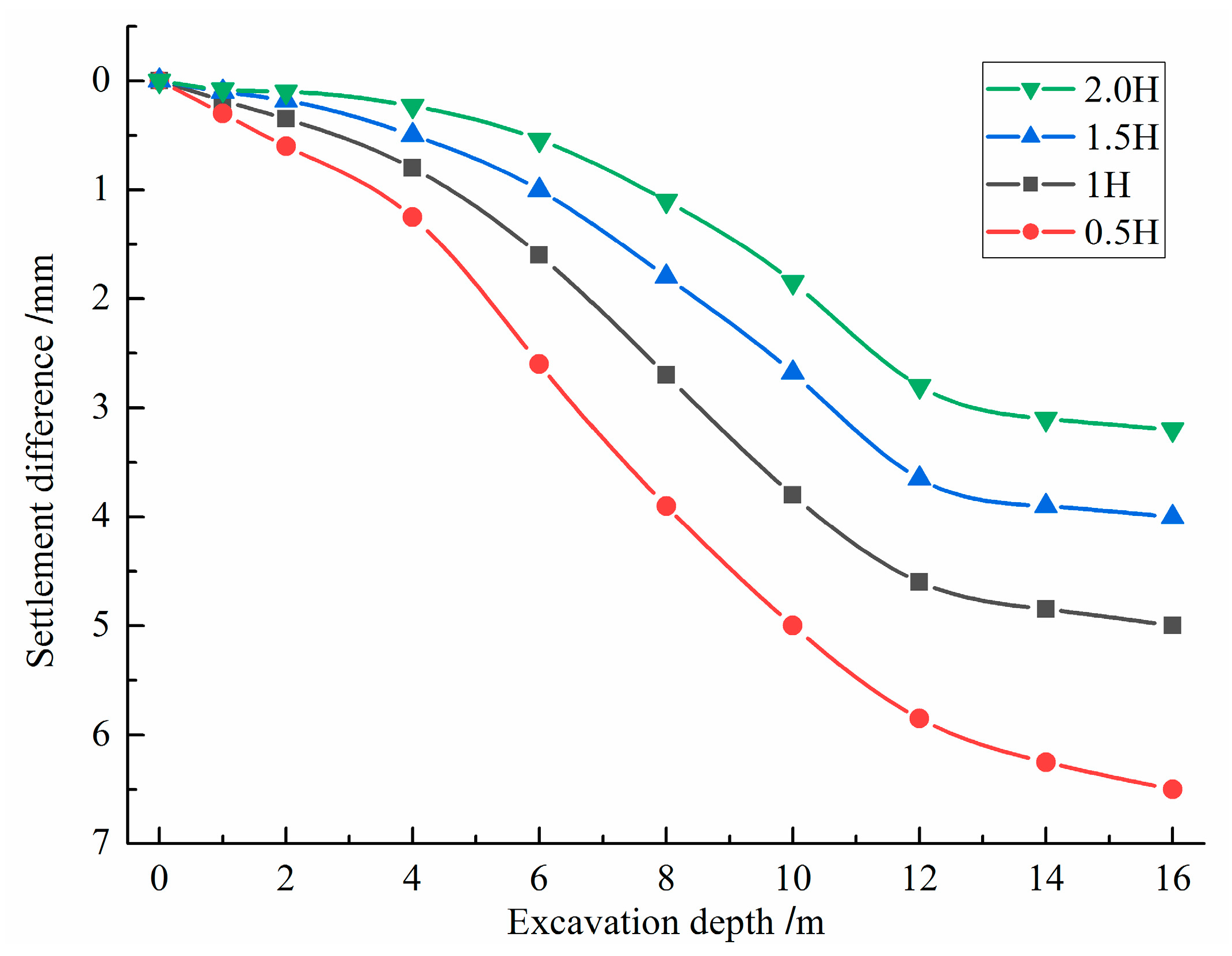

| Process Name | Foundation Pit Support | Excavation Depth | Construction Remarks |
|---|---|---|---|
| Construction Preparation | — | 0 m | Underground diaphragm wall construction |
| Excavation Stage 1 | Set up the first support | 2.5 m | Reinforced concrete support |
| Excavation Stage 2 | Set up the second support | 6.5 m | Steel support |
| Excavation Stage 3 | Set up the third support | 12 m | Steel support |
| Excavation Stage 4 | Pour foundation pit floor | 15 m | —— |
| Soil Thickness (m) | Soil Type | Cohesion (kPa) | Friction Angle (º) | Unit Weight (kN/m3) | Poisson’s Ratio | (kPa) | (kPa) | (kPa) |
|---|---|---|---|---|---|---|---|---|
| 0–3 | Miscellaneous Fill | 5.5 | 4.2 | 17 | 0.32 | 5200 | 5200 | 15,600 |
| 3–6.5 | Muddy Clay | 18.2 | 17.5 | 18.5 | 0.28 | 6000 | 6000 | 18,000 |
| 6.5–8 | Silty Clay | 8.6 | 12.6 | 18 | 0.35 | 8700 | 8700 | 26,100 |
| 8–12 | Hard Plastic Silty Clay | 26.1 | 28.6 | 19.5 | 0.28 | 14,500 | 14,500 | 43,500 |
| 12–23 | Strongly Weathered Argillaceous Siltstone | 20.5 | 3.5 | 23.2 | 0.32 | 23,000 | 23,000 | 69,000 |
| Structure Type | Elastic Modulus (MPa) | Unit Weight (kN/m3) | Poisson’s Ratio |
|---|---|---|---|
| Crown Beam | 25,000 | 25 | 0.2 |
| Diaphragm Wall | 25,000 | 25 | 0.2 |
| Concrete Support | 25,000 | 25 | 0.2 |
| Steel Support | 210,000 | 78 | 0.3 |
| MJS Pile | 400 | 18 | 0.32 |
| Building Wall | 2000 | 23 | 0.25 |
| Building Foundation | 2000 | 23 | 0.25 |
| Maximum Shear Strain/% | Damage Degree of Building |
|---|---|
| 0–0.05 | Negligible |
| 0.05–0.15 | Slight |
| 0.15–0.3 | Medium |
| >0.3 | Serious |
Disclaimer/Publisher’s Note: The statements, opinions and data contained in all publications are solely those of the individual author(s) and contributor(s) and not of MDPI and/or the editor(s). MDPI and/or the editor(s) disclaim responsibility for any injury to people or property resulting from any ideas, methods, instructions or products referred to in the content. |
© 2023 by the author. Licensee MDPI, Basel, Switzerland. This article is an open access article distributed under the terms and conditions of the Creative Commons Attribution (CC BY) license (https://creativecommons.org/licenses/by/4.0/).
Share and Cite
Zhang, D. Influences of Deep Foundation Pit Excavation on the Stability of Adjacent Ancient Buildings. Buildings 2023, 13, 2004. https://doi.org/10.3390/buildings13082004
Zhang D. Influences of Deep Foundation Pit Excavation on the Stability of Adjacent Ancient Buildings. Buildings. 2023; 13(8):2004. https://doi.org/10.3390/buildings13082004
Chicago/Turabian StyleZhang, Dandan. 2023. "Influences of Deep Foundation Pit Excavation on the Stability of Adjacent Ancient Buildings" Buildings 13, no. 8: 2004. https://doi.org/10.3390/buildings13082004
APA StyleZhang, D. (2023). Influences of Deep Foundation Pit Excavation on the Stability of Adjacent Ancient Buildings. Buildings, 13(8), 2004. https://doi.org/10.3390/buildings13082004





